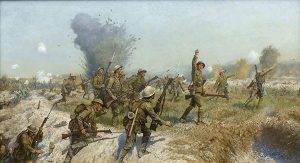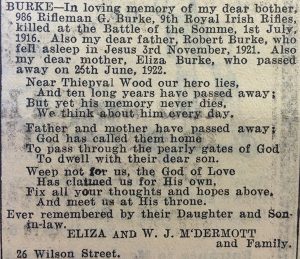Why I commemorate the Somme
Published in Issue 4 (July/August 2016), Platform, Volume 24By Jason Burke

Above: James Prinsep Beadle’s Battle of the Somme: Attack of the Ulster Division, 1 July 1916. (Belfast City Hall)
‘A hundred years hence, men will be delving into our records of the late war. Soldiers will be studying the lessons of its battles. But yet a greater number of seekers will be demanding with curiosity how men lived in such circumstances, how they reacted to the strain of war, and what compensations they found.’
And how right he was. As we find ourselves in the midst of the centenary of the Great War, and the Battle of the Somme in particular, awareness has never been greater and interest has never been so intense.
The Battle of the Somme was initially hatched as a plan that would win the war, but by June 1916 it had become an exercise in keeping the allies in the war. Since then the Somme has become a byword for futility and incompetence, in spite of the fact that it was a pivotal moment in the conflict and arguably created the circumstances for the allies to go on and win the war in 1918.
My own interest in this period dates back to my childhood in East Belfast, when I grew up in streets that were named after sites from the battle: Somme Drive, Thiepval Avenue, Albert Drive, Bapaume Avenue, Picardy Avenue and Hamel Drive. These were streets and houses purposely built for ex-servicemen returning from the Great War; they were to be ‘homes fit for heroes’ (the late Keith Jeffery remarked that ‘a little corner of an Ulster/Irish field would be forever France’). For others, though, their interest is sparked by a sepia photograph of a uniformed man with a story to tell—in other words,by a personal family connection.It is often said that barely a family in Ulsterwas left untouched by the huge human loss of the Somme, yet until recently I thought that I was the exception to this rule; I was aware of no relation who had served in the Great War, less still the Somme.

Above: The memorial notice for George Burke on the tenth anniversary of his death in the Belfast Evening Telegraph,1 July 1926—no mention of Ulster, Empire or loyalty.
With aching hearts we shook his hand,
Tears glistening in our eyes.
We wished him luck, but never thought
It was our last goodbye.
Far away from those who loved him
His comrades laid him to rest,
In a far-away grave he is sleeping,
One of the bravest and best.
Another:
Near Thiepval Wood our hero lies,
and ten long years have passed away;
but yet his memory never dies,
We think about him every day.
Here was a man who signed the Ulster Covenant in 1912 andwas likely to have been involved with anti-Home Rule unionist militancy in the Shankill district of Belfast, yetthere was no mention of Ulster, Empire or loyalty in the notices from his family.In contrast, the rest of the newspaperfeatured articles which suggested that the Somme was a glorious battle, a triumph from failure, yet in the memorial section there was clear evidence of family pain and suffering.From this single experience we can identify one of the key factors of Somme commemoration: personal loss. When we peel away the complex layers of sacrifice at the Somme, from politics and patriotism to youthful exuberance, we are left with a phenomenal level of raw personal loss and trauma. Indeed, in this respect the Irish experience is no different from that of Great Britain.The personal element has been one of the few consistent features within the spectrum of variables that is Somme commemoration since 1916.
This, however, does not help us to clarify why the Somme in particular has become a much-commemorated event. The scale ofthe loss cannot be the sole reason for Somme obsession; if it were, then the obsession would not be with the Somme but with some other catastrophe like Gallipoli, Spanish Influenzaor the Belfast Blitz. The unionist/loyalist community in Ulster, for example, have immortalised the Somme story, one that is rooted in the actions of the 36th(Ulster) Division on 1 and 2 July and their 5,700 casualties acrossthose two days. For them, what makes the Somme deathless, and therefore the focus of the obsession, is the concentration of that loss on an overwhelmingly Ulster Protestant division with its roots in pre-war militant unionism. Add to that the fact that the affected geographical area of Ulster is small by comparison, combined with the phenomenal personal loss, and when viewed through the lens of a troubled relationship with the British government it can equate to an ‘Ulster blood-sacrifice’.Certainly the unionist leadership at the time felt that the bloodshed at the Somme, on behalf of the Empire, made their position in Ulster non-negotiable. In this context the idea of widespread unionist/loyalist commemoration of the Somme should not surprise us, but neither should it concern us.Loyalists have been criticised recently for staging Somme commemorations and have been accused of attempting to appropriate the Somme story as their own, but such accusations are ignorant of the personal aspect, which is a fundamental feature.
And to that end my great-uncle played a part, whether I like it or not. Should I, therefore,be commemorating him and the Somme more generally?Perhaps the construction of this article is an act of commemoration in its own way, and yet I feel that this is singularly the best way to honour him and the wider Somme battle, through education and informed discussion. It would be remiss of us not to question why these men were at the Somme in the first place, what they hoped to achieve and what, if anything, they did achieve. As a young historian, I see the Somme centenary not as an opportunity to engage in jingoism and patriotic wreath-laying but as an opportunity to engage with such challenging questions and to investigate the constant stream of new resources:ultimately, to fulfil the prophecy of Cyril Falls that ‘a hundred years hence, men will be delving into our records of the late war… demanding with curiosity how men lived in such circumstances, how they reacted to the strain of war, and what compensations they found’.
Jason Burke is a researcher with the East Belfast and the Great War Research Project.
















